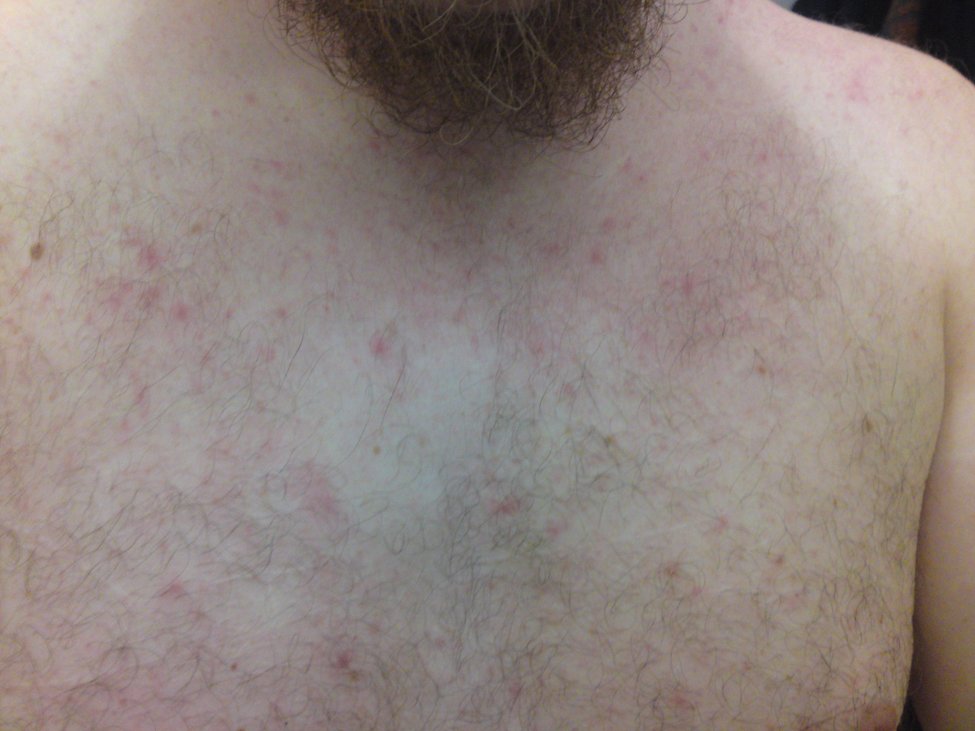Miliaria
(Redirected from Heat rash)
Editor-In-Chief: Prab R Tumpati, MD
Obesity, Sleep & Internal medicine
Founder, WikiMD Wellnesspedia &
W8MD medical weight loss NYC and sleep center NYC
| Miliaria | |
|---|---|

| |
| Synonyms | Heat rash, prickly heat |
| Pronounce | N/A |
| Specialty | N/A |
| Symptoms | Itching, red rash, blisters |
| Complications | Secondary infection |
| Onset | Hot and humid weather |
| Duration | Days to weeks |
| Types | N/A |
| Causes | Blocked sweat ducts |
| Risks | Hot climate, excessive sweating |
| Diagnosis | Clinical examination |
| Differential diagnosis | Folliculitis, contact dermatitis |
| Prevention | Cool environment, loose clothing |
| Treatment | Cooling the skin, topical steroids |
| Medication | N/A |
| Prognosis | N/A |
| Frequency | Common in tropical climates |
| Deaths | N/A |
.
Miliaria is a common skin condition characterized by small vesicular, papular, or pustular rashes, usually not exceeding one millimeter in size. Often referred to as "heat rash," "prickly heat," or "sweat rash," miliaria is primarily associated with heat, fever, or the occlusion of sweat glands.
Introduction[edit | edit source]
Miliaria occurs when sweat is trapped beneath the skin, leading to irritation and inflammation. This can cause blockage of the sweat ducts, subsequently leading to the formation of itchy rashes.
Causes[edit | edit source]
The primary causes of miliaria include:
- Heat: Prolonged exposure to high temperatures can cause excessive sweating, leading to blocked sweat ducts.
- Fever: Elevated body temperatures can trigger miliaria.
- Occlusion: Anything that obstructs the free flow of sweat on the skin surface, such as tight clothing or certain creams and ointments, can induce the condition.
Types[edit | edit source]
Miliaria can be classified based on the depth of the blocked sweat duct:
- Miliaria crystallina: Affects the sweat ducts in the topmost layer of the skin. It produces clear, fluid-filled blisters and bumps.
- Miliaria rubra: Commonly known as "prickly heat," it affects the deeper layers of the epidermis. It results in red bumps and can be accompanied by inflammation and itching.
Symptoms[edit | edit source]
- Small vesicular, papular, or pustular rashes
- Itching or "prickly" sensations
- Redness of the affected area
Prevention and Treatment[edit | edit source]
- Avoid prolonged exposure to heat.
- Wear loose-fitting clothing to allow skin to breathe.
- Showering with cool water and using gentle, unscented soaps.
- Applying over-the-counter creams with calamine or other anti-itch ingredients.
- Keeping the affected area dry and clean.
Summary[edit | edit source]
A small (one mm or less) vesicular, papular or pustular monomorphous rash, which is associated with heat, fever or occlusion of sweat glands.
See Also[edit | edit source]
Search WikiMD
Ad.Tired of being Overweight? Try W8MD's physician weight loss program.
Semaglutide (Ozempic / Wegovy and Tirzepatide (Mounjaro / Zepbound) available.
Advertise on WikiMD
|
WikiMD's Wellness Encyclopedia |
| Let Food Be Thy Medicine Medicine Thy Food - Hippocrates |
Translate this page: - East Asian
中文,
日本,
한국어,
South Asian
हिन्दी,
தமிழ்,
తెలుగు,
Urdu,
ಕನ್ನಡ,
Southeast Asian
Indonesian,
Vietnamese,
Thai,
မြန်မာဘာသာ,
বাংলা
European
español,
Deutsch,
français,
Greek,
português do Brasil,
polski,
română,
русский,
Nederlands,
norsk,
svenska,
suomi,
Italian
Middle Eastern & African
عربى,
Turkish,
Persian,
Hebrew,
Afrikaans,
isiZulu,
Kiswahili,
Other
Bulgarian,
Hungarian,
Czech,
Swedish,
മലയാളം,
मराठी,
ਪੰਜਾਬੀ,
ગુજરાતી,
Portuguese,
Ukrainian
Medical Disclaimer: WikiMD is not a substitute for professional medical advice. The information on WikiMD is provided as an information resource only, may be incorrect, outdated or misleading, and is not to be used or relied on for any diagnostic or treatment purposes. Please consult your health care provider before making any healthcare decisions or for guidance about a specific medical condition. WikiMD expressly disclaims responsibility, and shall have no liability, for any damages, loss, injury, or liability whatsoever suffered as a result of your reliance on the information contained in this site. By visiting this site you agree to the foregoing terms and conditions, which may from time to time be changed or supplemented by WikiMD. If you do not agree to the foregoing terms and conditions, you should not enter or use this site. See full disclaimer.
Credits:Most images are courtesy of Wikimedia commons, and templates, categories Wikipedia, licensed under CC BY SA or similar.
Contributors: Kondreddy Naveen, Prab R. Tumpati, MD


